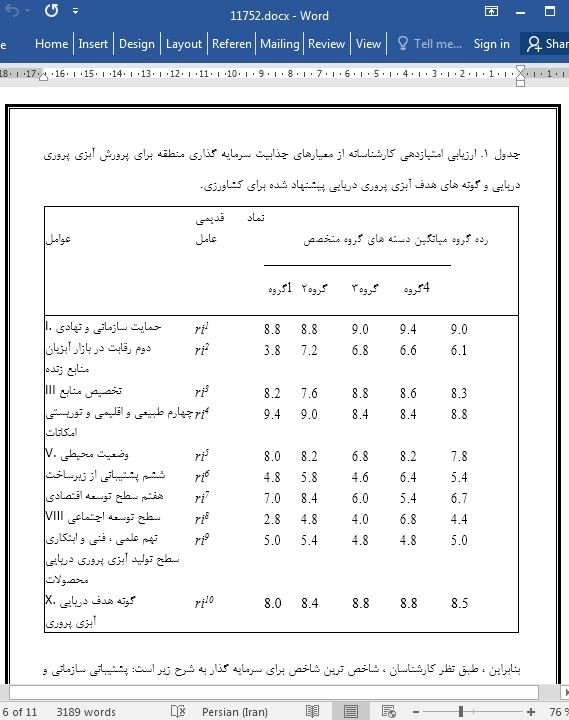
جذب سرمایه حوزه آبزی پروری و نمونه های هدف آبزی پروری دریایی
چکیده
براساس سیستم های شاخص طراحی شده بمنظور ارزیابی جذب سرمایه حوزه آبزی پروری و گونه های هدف برای آبزی پروری دریایی باکمک ارزیابی متخصصین و روشهای ABC، این تحقیق موثرترین و بنیادین ترین عواملی را شناسایی می کنند که جذب سرمایه بخش آبزی پروری مجتمع شیلات منطقه ای را ایجاد می کنند. اینگونه به اثبات رسیده که جذب سرمایه حوزه آبزی پروری و میزان سرمایه های مالی در اهداف آبزی پروری نخست به تشکیل حمایت مناسب نهادی و سازمانی وابسته است که تحت این عنوان از میزان بیش تنظیمی شغلی می کاهد(ساده سازی شرایط اختصاص موقعیتهای شیلات، روشی به منظور کسب مجوز در راستای رشد سیستم های آبزی پروری دریایی وتضمین کارآمدی مکانیزم کنترل و نظارت.
1.مقدمه
مجتمع شیلات و آبزی پروری دریایی بعنوان مولفه های مهم در بخش مواد غذایی عمل کرده اند و نقش ویژه ای در حل مشکل تغذیه متعادل جمعیت ایفا کرده اند. بااینحال، در حال حاضر،منابع آبزی پروری ملی موجود مصرف چندانی ندارند. موقعیت و تاثیر عملکرد مجتمع شیلات منطقه ای بطور قابل توجهی از شیلات پیشرفته عقب است و الزامات جامعه مدرن را تامین نمی کند که به دلیل وابستگی قابل توجه بازار ماهی به واردات محصولات ساخته شده از منابع آبزی زنده در برابر شرایط بحرانی شرکت های شیلات داخلی و مزارع پرورش آبزیان دریایی و همچنین کنترل ناکافی در بخش سایه ماهیگیری ، نقص در سیستم پشتیبانی و کنترل دولت در این زمینه ، درجه بالایی از بار مالیاتی در مزارع پرورش آبزیان و تنظیم بیش از حد کشاورزی توسط الکساخینا و ترگولوا می باشد(2016). همه عوامل فوق عدم تمایل سرمایه گذاران به بهره گیری پول در توسعه صنعت ماهیگیری به طور کلی و همچنین پرورش آبزیان دریایی به ویژه توسط یارکینا و لوگنوا (2019) را تعیین می کند.
Abstract
Based on the designed system of indicators to evaluate the investment attractiveness of the area for marine farming and the target species for marine aquaculture using expert assessment and ABC methods, the research identifies the most significant, fundamental factors that create the investment attractiveness of the marine aquaculture component of the regional fishery complex. It is proved that the investment attractiveness of the area for marine farming and the amount of financial investments in marine aquaculture objects, first of all, depend on the formation of the appropriate organizational and institutional support, namely reducing the degree of business overregulation (simplifying the conditions for allocation of fishery grounds, the procedure for obtaining permission to grow target marine aquaculture species and certification systems for fishery and farming grounds) and ensuring the effectiveness of the mechanism for control and supervision of the illegal harvesting of marine aquaculture species.
1. Introduction
The fishery complex and marine aquaculture as its important component traditionally act as important elements of the food facility and play a significant role in solving the problem of balanced nutrition of the population. However, at present, the available national marine aquaculture resources are not much used. The state and effectiveness of the functioning of the regional fisheries complex lags significantly behind the advanced fisheries and does not meet the requirements of the modern society, which is due to the significant dependence of the fish market on imports of products made of living aquatic resources against the background of the crisis state of domestic fishery enterprises and marine aquaculture farms, as well as insufficient control of the shadow sector of fisheries, imperfection of the state support and control enforcement system in this area, a high degree of tax burden on aquaculture farms and overregulation of the farming by Aleksakhina and Tregulova (2016). All of the above factors determine the reluctance of investors to plow money in the development of both the fishing industry as a whole and marine aquaculture in particular by Yarkina and Logunova (2019).
چکیده
1.مقدمه
2.مواد وروشها
3.نتایج
4. بحث
5. نتیجه گیری
منابع
Abstract
1. Introduction
2. Materials and Methods
3. Results
4. Discussion
5. . Conclusions
References
- اصل مقاله انگلیسی با فرمت ورد (word) با قابلیت ویرایش
- ترجمه فارسی مقاله با فرمت ورد (word) با قابلیت ویرایش، بدون آرم سایت ای ترجمه
- ترجمه فارسی مقاله با فرمت pdf، بدون آرم سایت ای ترجمه



